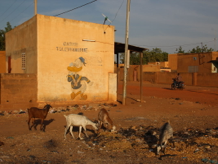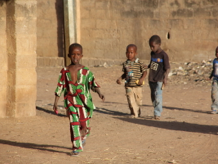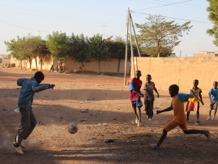From Houston to Sydney 2013

West Africa
2014
After two consecutive disrupted nights, it was wonderful to get a normal night’s sleep lying in a bed last night, and I have felt much better for it today.
We rose at 7 am, showered in water that was aspirationally hot, enjoyed a plain but adequate breakfast, and we were on the road at 8:30 am, heading along Mali’s major national highway to the country’s second largest city, Segou (population about 900,000 people).
The road may be Mali’s finest, but the quality of the route was variable indeed. Much of it had not seen any repairs since I last travelled on it ten years ago (and it had more than its share of large potholes even then), while other sections had deteriorated markedly. On the bright side, work has started on rebuilding the road under a contract given to the Chinese Government, and those sections of the road that had been rebuilt were excellent in every way.
The drive of 235 kilometres took us about four and a half hours, with just two brief stops – one to have a close look at some small termite mounds in a grassy field, and a second to look at some trees whose seeds are used to make a skin cream. Yes, you guessed correctly – the drive from Bamako to Segou is probably the least interesting driving sector for this itinerary.
Having said that, there were lots of interesting things to see during the drive that did not warrant a stop. The drive was mainly through semi-arid scrub country with small linear villages at irregular intervals. The main road through each of the villages was lined with stalls selling household goods, vegetables, water, tyres, fruit, fuelwood, fuel (including petrol in recycled glass bottles for motor cycles), and lots more. The villages were colourful hubs of activity, with animals roaming freely, women dressed in brightly coloured print dresses with local designs, minibuses surrounded by vendors vying to sell food and drinks to the passengers inside, with animal dung and waste shredded plastic bags blowing in the wind being constant ‘decorations’.
We arrived in Segou at a little after 1:00 pm, and went straight to our hotel to check in. Our hotel, the Hotel Independance (not a spelling mistake) had a lovely layout with shady courtyards and huge but plain rooms. The staff helpfully checked that everything in the room was working when we arrived at our room, including a thorough but puzzling check that bidet was working for the two of us (and yes, my son, like me, is male).
We enjoyed quite generous meals in the hotel’s dining room – a hamburger with potato fries for me (with a huge meat patty made from extremely finely minced local longhorn cattle that I am sure was fat-free, grass-fed and hormone-free), and an African-style chicken pizza for Andrew (African style chicken means there is not much meat, lots of gristle and a more than adequate number of small bones).
After lunch, we had time for a short rest before meeting Mama to go for a guided walk through the suburb of Segou where our hotel is situated. Our walk began south-east along the main road (Route Nationale 6) where our hotel is located until we came to a large former quarry from which the French had mined clay for use in road construction during the colonial era. On one side of the quarry was a collective workshop where textiles (or more specifically, mud-cloth) were being made using traditional techniques. The designs were very artistic and delightful to look at; I wish I had the wall space at home to display some of these wonderful creations.
After looking through the workshop, we spent the next two hours walking slowly in a large circuit through the suburban streets of the neighbourhood. Our walk began near the district market, but being late on a Saturday afternoon, most of the stalls were vacant. There were just a few ladies selling vegetables, and one shelter where two men were “ironing” clothes by beating them with large wooden mallets.
The streets were similarly fairly quiet (this was a suburban neighbourhood, after all), but interesting nonetheless. The streets were wide, having been laid out in a grid pattern during the French colonial era. They were unpaved and dusty, and lined by high walls that hid the yards and houses behind from street view. Cattle and goats roamed fairly freely, foraging through the extensive piles of garbage that took up much of the space in the streets – this place clearly does not have a waste collection service! Not only cattle were foraging through the garbage – small children whose parents were unemployed were sorting through the garbage too, trying to scavenge small pieces of charcoal to take home for use as a cooking fuel.
The smell of smoke was one of the pervasive features of the walk. Fuelwood is used for cooking in most of the homes, with charcoal also used – both generate prodigious quantities of smoke. In Bamako, more wealthy people have access to gas, but there was little evidence of this luxury in the suburban streets we walked through this afternoon.
By the time we finished our walk at 6:00 pm, it was dusk, with the smoke making the sky appear darker than it should have been at that hour. Having had such a large and late lunch, neither Andrew nor I felt like a large dinner, so we agreed to finish the day with just a chocolate crepe and a banana each, washed down with a cold bottle of Coke.

Day 8 - Bamako to Segou, Mali
Saturday
4 January 2014







































